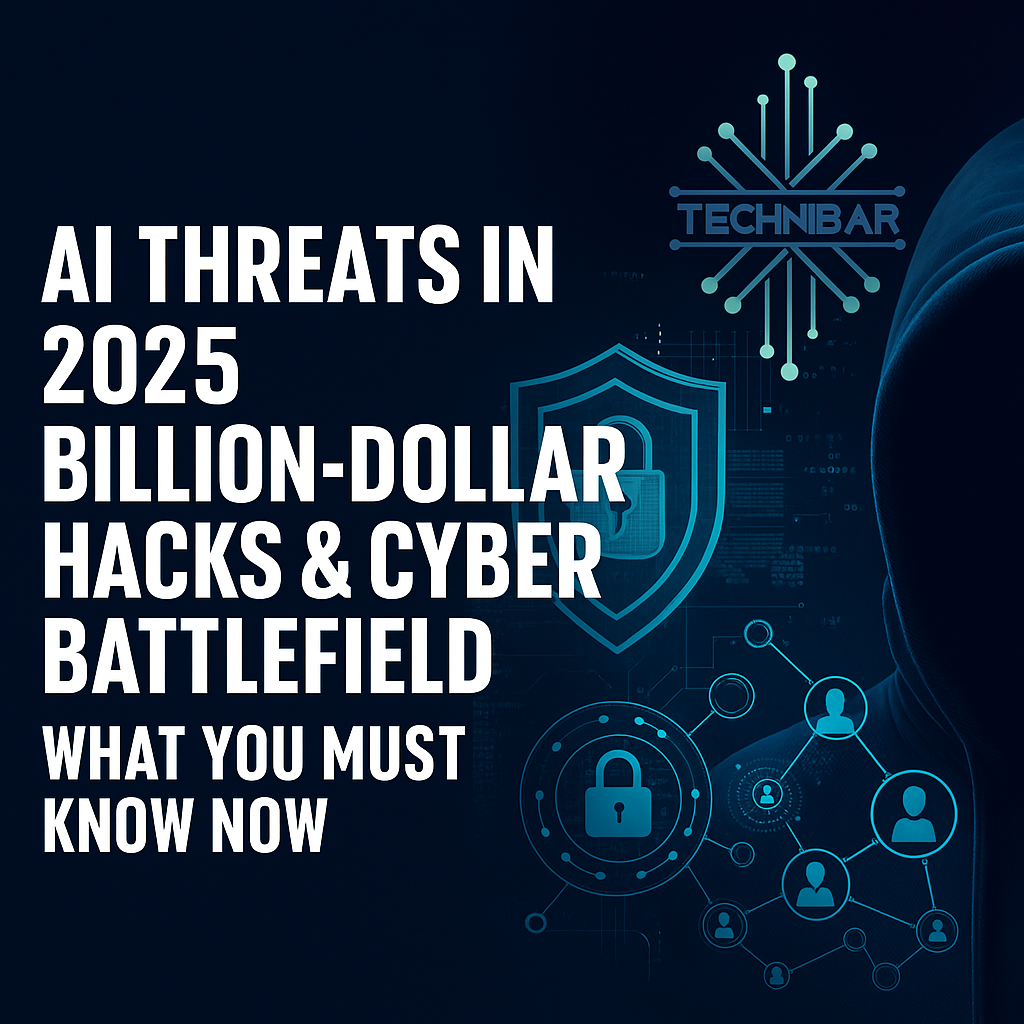AI threats in 2025 are no longer only an issue for IT; it affects everyone. The digital world is at a critical point in its history as we enter 2025. AI has become a robust defense and a lethal attacker this year. Everything is at risk now, from your money to the safety of the whole country. What makes 2025 so crucial? For the first time, the threats in cyberspace are rising stronger and quicker than we can protect ourselves. AI is helping security teams and offering hackers, scammers, and hostile countries greater tools. In this post, you’ll talk about how AI is transforming cyberattacks, point out billion-dollar breaches, and inform people and businesses about what they need to do to be safe.
1. Basics of AI Threats in 2025
People communicate with each other online in new ways thanks to AI. So, attackers find a way because they are increasingly more intelligent, faster, and harder. Let’s learn how they work.
Driven Malware & Automated Exploits
Viruses that don’t change are no longer around. In 2025, malware that uses AI changes in real time to stay hidden. SentinelOne and other programs find malware types that modify code while executing. They can readily sneak past firewalls and sandboxing tools. At the same time, hackers are simultaneously using automated tools to look for weak spots on thousands of systems.
Furthermore, TechRadar states that these bots can scan up to 36,000 targets every second and often steal login information or launch brute-force attacks. This much automation means that as soon as a defect is made public, or maybe even before, it’s already being used on a big scale.
AI-Enabled Phishing, Spear Phishing & Deepfakes
Phishing is different now. In 2025, AI can produce emails, SMS, and websites that look real in just a few seconds. These scammers don’t make regular grammatical blunders. They talk nicely, are well-organized, and work well. According to Exploding Topics, the number of people who fell for phishing schemes has doubled in the last year. Scammers can change the content based on the recipient’s past behavior, preferences, and actions, all of which come from scraped data and AI-enhanced profiling.
Deepfake technology is another huge concern. People who commit fraud have used false voices and faces to act like CEOs, government officials, and friends they can trust. People have exploited AI-generated video to take over meetings. The Australian and Politico believe that voice cloning has made it possible for wire fraud schemes worth millions of dollars.
Moreover, researchers have found that trained security teams or technology miss 66% of AI-generated voice attacks and 43% of deepfake video interactions (arXiv).
LLM Exploits & Prompt Injection: AI Threats in 2025
Many companies use Large Language Models (LLMs), which are very easy to hack. Cybercriminals are utilizing rapid injection attacks on these models to get them to give up private information or do bad things. Business Insider believes that more and more models, like Gemini and DeepSeek, are being hijacked.
In one case, attackers could get past safety filters by utilizing input that looked safe. They received information inside the system, leaked database structures, and did things they didn’t mean to do because the prompts had been changed. Because many LLMs are black boxes, organizations usually don’t know they’ve been taken advantage of until much later. Apps that use AI have a hard time with that.
2. High Profile Billion Dollar Breaches & Emerging Attack Vectors
The AI cyberwar is already costing a lot of money and hurting big businesses. Let’s go on for more in-depth conversation.
Major 2025 Breaches & Nation-State Campaigns
In early 2025, threat groups connected to China used a zero-day flaw in Microsoft SharePoint to get into several U.S. federal agencies. Politico said these people went unreported for weeks while stealing important papers and causing trouble. In April 2025, U.S. financial regulators were attacked by other breaches.
The Moroccan government has European data centers run by Royal Mail and Hertz. People plotted these attacks. CSIS and CM Alliance say that most of them were part of coordinated actions by countries. The goal was just having information, harming the economy, and getting a long-term strategic advantage.
Multi-Billion Dollar Financial Impacts
The prices are sky-high. A compromise in a third-party CRM made Allianz, a large insurance firm in Germany, lose control of customer data. The total cost might be over $1.2 billion, and more than 1.4 million clients were affected (FT.com). Karnataka state in India lost ₹938 crore (approximately $110 million) between January and May 2025.
The Times of India says that 80% of these scams were AI-powered phishing attacks. Cyber security Ventures said that analysts believe the worldwide cost of cybercrime would go above $10.5 trillion by 2025 and reach $13.8 trillion by 2030. That’s more than what Japan’s GDP is.
3. Cyber Battlefield of 2025: Actors, Tools & Motivations
Who is behind these attacks? Not just hackers are anonymous anymore. Let’s find each other.
State & Organized Threat Actors
According to Europol, organized crime is getting faster because of AI. Crime gangs utilize deepfakes to extort people, AI bots to steal identities, and coordinated attacks to spread ransomware. Things are becoming worse because of tensions between countries. Intelligence specialists believe that China, Russia, Iran, and North Korea will take more aggressive steps as problems across the world get worse. The Australian adds that these governments are adding AI to their military-grade cyber units, which combine eavesdropping with economic warfare.
Ransomware as a Service (RaaS) & MSP Vulnerabilities
Ransomware-as-a-service (RaaS) is quite popular in 2025. LockBit 3.0 and Ransomhub are two groups that make malware kits that are simple to use right now. People who aren’t experts can nevertheless launch fatal attacks. These criminals typically use “living-off-the-land” ways to stay hidden by exploiting technologies already on the system for other things. Managed service providers (MSPs) are also under attack. Darktrace and ITPro report that 45% of MSPs have a “ransom kitty,” money put aside to pay off attackers. And 44% stated they worry more about AI hazards than traditional malware or ransomware.
4. AI and Quantum: The Future of Risk in Financial Systems.
Artificial intelligence is also changing the way we think about financial crime.
AI in Attacks on Fintech
Attackers use AI to get information from social media and launch automated fraud efforts. Get past systems that check your identity. These capabilities let you update financial data quickly, especially on decentralized finance (DeFi) platforms and crypto exchanges.
Quantum Threats
Quantum computing is a different kind of risk. Now, enemies are “harvesting encrypted data today” to decrypt it later using quantum computers. This strategy is called “harvest now, decrypt later.” It puts even the data that is currently safe at risk. Experts suggest we need to switch to post-quantum cryptography standards right away, according to recent articles on arXiv. If you wait too long, you can leave years of private financial information available.
5. Main Defensive Strategies: What Organizations Must Do Now
There is still hope, even when things look bad. But something needs to be done immediately.
Identity and Zero Trust Controls
Companies must avoid utilizing security models based on the outside. Instead, they need Zero Trust designs, meaning no device or user is trusted by default. It is crucial to have specific authentication, session validation that happens in real time, and monitoring that is always on. Right now, voice-based identification verification is also relatively weak. Sam Altman from OpenAI is one of several security experts who recommend switching to multifactor methods (Windows Central).
AI-First Defenses and Spotting
AI is the only thing that can stop itself. Big companies are using AI-powered detection tools more and more. These systems look for patterns, behaviors, and even natural language to discover dangers before they arise. Defenders using big language models can stop bad prompts and check on internal models to ensure they haven’t been compromised. When utilized with access controls and logging, they make a good shield.
Cyber Hygiene, Patch Management & Supply Chain Oversight
Keep an eye on the supply chain, patch management, and cyber hygiene. It’s crucial to take simple steps. Make sure to update your software often. Look on the dark web for usernames and passwords that have been stolen.
Make sure that merchants stick to strict safety requirements.What makes your supply chain strong is its weakest link. IBM and other corporations underline real-time monitoring partners’ importance and third-party networks’ importance.
Regulation & International Collaboration
Businesses aren’t the only ones worrying about cybersecurity. The governments are doing more. The EU hires twice as many people to work on cybercrime at Europol. More and more, countries are sharing information. Regulators worldwide strive to ensure that AI crimes are treated the same way. There is also a lot of pressure to define and follow rules for post-quantum cryptography. But it’s vital to work together.
6. Implications & Actionable Takeaways
What does this mean for you, your business, or your country?
- Keeping the Person Safe: Don’t believe calls or videos from people you don’t know; they could be phony.
- Use hardware-based MFA.
- Don’t post personal information online.
- Make plans for how to deal with problems.
- Do simulations of threats.
- Support legislation that keeps AI safe.
- Invest in infrastructure that can handle quantum attacks.
- Get people of all ages to learn about how to stay safe online.
Final words
It’s not just another year; it’s a time of change. AI is now the most significant threat and the finest protection in cybersecurity. Right now, there are billion-dollar cyberattacks, attacks backed by the government, and scams that exploit AI. It’s getting late. You need to adapt quickly, use clever technology, and be on your toes, or you could fall behind on the cyber battlefield, which is constantly increasing Artificial intelligence Threats in 2025.
FAQs
1. What will be the biggest cyber threat among all AI Threats in 2025?
The biggest concerns are AI-driven phishing and malware that updates in real time and uses deepfake technology to fool users.
2. How are hackers using AI in phishing attacks?
Hackers use AI to produce fake texts, noises, and even movies that look real. These tools let them trick consumers into giving them private information or letting them make payments.
3. What industries are most vulnerable?
The financial services, healthcare, and government industries are frequent targets because they have a lot of data and antiquated systems.
4. Can AI be used for defense too?
Yes. AI helps discover unexpected activities, watch systems constantly, and respond to threats faster than people can.
5. How can I protect myself against AI-based cybercrime?
Use strong passwords, turn on multifactor authentication, don’t click on links to sites you don’t know, and check calls or videos through other means.








